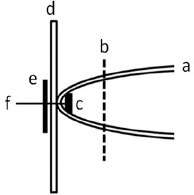BACKGROUND
First reported in 1990, buried bumper syndrome (BBS) is a rare complication of long-term percutaneous endoscopic gastrostomy (PEG) feeding.1 An overgrowth of gastric mucosa buries the internal bumper, resulting in luminal mechanical obstruction. The patient experiences discomfort and discharge from the exit site.2 Where endoscopic techniques fail, laparotomy may become necessary for BBS.3,4 We describe a laparoscopic technique for PEG dependent patients where attempts at endoscopic removal fail.
TECHNIQUE
A completely buried bumper is confirmed by endoscopy. The peritoneal cavity is accessed via three ports. The stomach is dissected away from the abdominal wall at the insertion site of the PEG tube. The portion of the stomach with the buried PEG bumper is divided with a 60mm endoscopic linear stapler (Echelon™ 60mm, Ethicon Endo-Surgery Inc, Cincinnati, OH, US) and removed through the umbilical port in an impervious bag (Fig 1). The staple line is checked endoscopically and a new PEG feeding tube placed using the standard technique.
Figure 1.

Schematic representation of the procedure (a = anterior stomach wall; b = staple line; c = internal buried bumper; d = anterior abdominal wall; e = external flange; f = percutaneous endoscopic gastrostomy tube)
DISCUSSION
Laparoscopic management of BBS has been reported previously by Ballester and Ammori, who describe a gastrostomy to remove the buried bumper and closure with intracorporeal suturing.5 However, in our experience limited partial stapled resection of the stomach minimises operative time. It allows removal of inflamed fibrosed tissue along with the bumper and can be safely carried out in selected cases. This approach offers the advantage of combining PEG replacement with removal of the buried bumper, allowing early commencement of feeding.
References
- 1.Klein S, Heare BR, Soloway RD. The ‘buried bumper syndrome’: a complication of percutaneous endoscopic gastrostomy. Am J Gastroenterol. 1990;85:448–451. [PubMed] [Google Scholar]
- 2.Gencosmanoglu R, Koç D, Tözün N. The buried bumper syndrome: migration of internal bumper of percutaneous endoscopic gastrostomy tube into the abdominal wall. J Gastroenterol. 2003;38:1,077–1,080. doi: 10.1007/s00535-003-1199-3. [DOI] [PubMed] [Google Scholar]
- 3.Binnebösel M, Klink CD, Otto J, et al. A safe and simple method for removal and replacement of a percutaneous endoscopic gastrostomy tube after ‘buried bumper syndrome’. Endoscopy. 2010;42:E17–18. doi: 10.1055/s-0029-1215367. [DOI] [PubMed] [Google Scholar]
- 4.Turner P, Deakin M. Percutaneous endoscopic gastrostomy tube removal and replacement after ‘buried bumper syndrome’: the simple way. Surg Endosc. 2009;23:1,914–1,917. doi: 10.1007/s00464-008-0299-9. [DOI] [PubMed] [Google Scholar]
- 5.Ballester P, Ammori BJ. Laparoscopic removal and replacement of tube gastrostomy in the management of buried bumper syndrome. The Internet Journal of Surgery. 2004:5. [Google Scholar]


